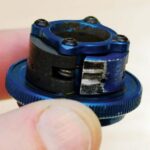Mastering the art of drifting in Forza Horizon 2 requires more than just skill; it demands a perfectly tuned car. This comprehensive guide will walk you through the crucial steps of transforming your ride into a sideways-sliding machine, covering everything from car selection and upgrades to in-depth tuning adjustments. Get ready to conquer corners and leave a trail of tire smoke in your wake.
Choosing the Right Chassis for Drifting
While rear-wheel drive (RWD) cars are generally preferred for drifting, avoid mid-engine or rear-engine vehicles as their weight distribution tends to favor grip over slip. Front-engine RWD cars provide a more balanced platform for initiating and controlling drifts. Remember, some cars can be converted to RWD after purchase, opening up more options for your drifting endeavors.
Essential Upgrades for Your Drift Car
Maximize your car’s drifting potential with these key upgrades:
Platform and Handling:
- Race Suspension: Opt for a full race suspension setup for optimal control and responsiveness. While weight reduction, roll cage, and anti-roll bars aren’t mandatory, they contribute to overall performance.
Drivetrain:
- Race Drivetrain: Upgrade to a full race drivetrain to handle the increased power and stress of drifting.
Wheels and Tires:
- Tire Compound: Choose street or sport tires for optimal grip. Avoid racing slicks as they are often restricted in competitive drifting.
- Tire Width: Experiment with wider rear tires for increased traction and drift initiation. Front tire width is a matter of personal preference; some drifters prefer wider fronts for increased steering response.
Aspiration:
- Turbo or Supercharger: Consider a single turbocharger or a supercharger for increased power. Be mindful of turbo lag, the delay between throttle input and boost delivery. While it can be challenging initially, learning to manage turbo lag can be advantageous for exiting corners with increased speed.
Engine Performance:
- Flywheel: A sport flywheel is recommended for improved engine response. While other performance upgrades are optional, aim for a horsepower range suitable for drifting. Around 400hp is a good starting point, but remember that excessively high horsepower can make the car difficult to control. Keep your car in the S class or lower, as R class cars are often excluded from competitions.
Fine-Tuning Your Drift Setup
Transforming your car into a drift weapon requires precise tuning. Here’s a breakdown of the essential adjustments:
Tire Pressure:
Optimal tire grip is typically achieved around 32 PSI. However, tire pressure increases with heat. Start with 28 PSI and adjust incrementally after test laps, monitoring tire pressure via telemetry until it reaches approximately 32 PSI while hot.
Alignment:
- Camber: Negative camber is crucial for maximizing tire contact during drifts. Start with -5 degrees in the front and -2 degrees in the rear. Adjust based on telemetry feedback, aiming for camber as close to 0 as possible without going positive during drifts.
- Toe: Positive toe in the front increases steering angle and drift initiation, but can reduce drift speed. Aim for 0 to -0.5 degrees of toe in the rear. Experiment to find what suits your driving style.
- Caster: Caster affects steering stability and responsiveness. Higher caster increases stability but reduces responsiveness, and vice versa. Experiment to find your preferred balance.
Suspension:
- Anti-Roll Bars, Springs, Rebound Stiffness: Calculate optimal settings using the formula: (A-B)C+B=X, where A is the stiffest setting, B is the softest, and C is the weight distribution percentage (front or rear). Fine-tune based on track conditions and personal preference. Stiffer suspensions are better for tight tracks, while softer suspensions suit high-speed courses.
- Ride Height: Slightly raise the front end higher than the rear for improved weight transfer under braking.
- Bump Stiffness: Set bump stiffness to 50-75% of the rebound stiffness value.
Brakes and Differentials:
- Brake Distribution: A 45% front bias is a good starting point. Adjust to personal preference.
- Brake Pressure: 120% is a good starting point, but adjust to your liking.
- Differentials: Higher acceleration and deceleration settings in the differential increase drift angle but also increase the risk of spinning out.
Gearing:
Find your “money gear,” typically 3rd or 4th, and adjust the final drive to avoid redlining or bogging down in that gear. Fine-tune individual gears if necessary. Aim for around 1000 RPM to spare before redline in your chosen gear.
This comprehensive tuning guide provides a solid foundation for building your ultimate drift car in Forza Horizon 2. Remember, fine-tuning is an ongoing process. Experiment, practice, and refine your setup to achieve drifting perfection!

